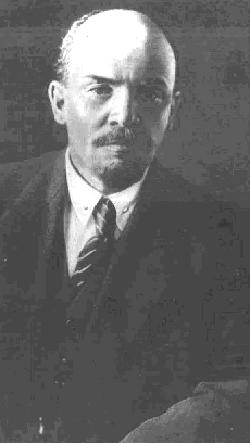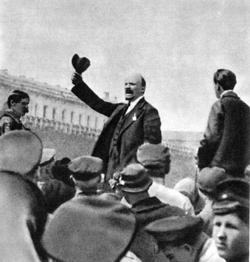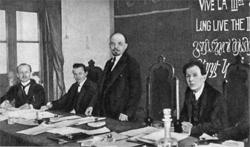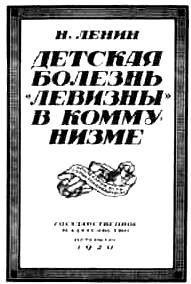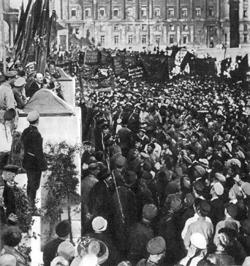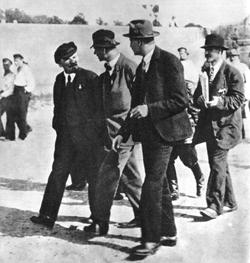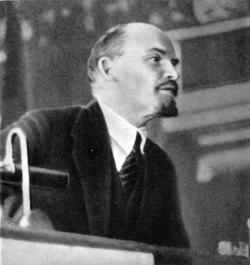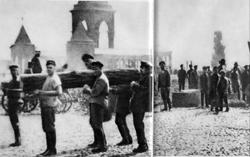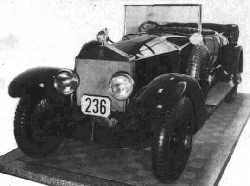Peaceful Respite.The Defeat of Interventionists and Internal Counter-revolution
V.I.Lenin July 1920ã.In the fierce battles in the summer and autumn of 1919, the Red Army utterly defeated the main forces of internal counter-revolution and the interventionists. The Soviet Republic received a peaceful respite. In spring 1920, the Ninth Congress of the Russian Communist Party ("Bolsheviks) took place in Moscow. The materials of the Congress defining the prospects of economic construction are presented in the exhibition: Lenin's "Letter to the Organisations of the Russian Communist Party (Bolsheviks) [RCP(B)] on the Preparation for the Party Congress", Report of the Central Committee made by V. I. Lenin, his questionnaire as delegate to the Ninth Congress, and others.
Lenin addressing the Vsevobuch parade.However, in April 1920, the imperialists made another attempt to smother the Soviet Republic. And again the Red Army soldiers set off to defend the gains of the October Revolution. A photograph of Lenin making a speech before the soldiers leaving for the Western Front is on the wall.
Vladimir Lenin in the Presidium of the First Congress of the Comintern. 1919.All these years Lenin was devoting great attention to the questions of world-wide Communist workers' and national liberation movements. The first edition of Lenin's work "Left-Wing" Communism, an Infantile Disorder, written in April and May 1920 is placed in this exposition. Generalising on the rich revolutionary experience of the Russian Bolsheviks and the international workers' movement, V. I. Lenin developed the Marxist theory and worked out the very important questions of strategy and tactics of proletarian parties in the new historical conditions, in the conditions of the existence and struggle of the two social systems. V. I. Lenin revealed sharply, and from positions of principle, the errors of the Left-wing "Communists", and showed the necessity of uncompromising struggle with all types of opportunists and revisionists. See also: Anatoly Lunacharsky. Lenin
and Russian revolution and other historical documents and photos at the Defend Lenin mausoleum! site.
Lenin's book "Left-Wing" Communism, an Infantile DisorderNext to the book "Left-Wing" Communism, an Infantile Disorder, (this book, as many others, was written under the pseudonym N. Lenin) various pages of its manuscript and editions in the languages of the various peoples of the USSR and foreign countries are on exhibit.
Lenin speaks at a meeting to mark the opening of the Second Congress of the Comintern. 1920.
Lenin at a meeting of one of the commissions of the Second Congress of the Comintern. 1920.
Lenin with a group of delegates to the Second Congress of the Comintern on the Field of Mars in Petrograd. 1920
Lenin presents a report on the international situation to the Second Congress of the Comintern. 1920.This work by Lenin was of great significance in the strengthening of the Third International; in July 1919, its delegates gathered at their Second Congress in Soviet Russia-beginning in Petrograd and continuing in Moscow. The photograph "V. I. Lenin Presents a Report on the International Situation and the Fundamental Tasks of the Communist International at a Meeting of the Second Congress of the Comintern, July 19, 1920", is displayed on the wall. Here also is verbatim record of this report with Lenin's corrections and a series of texts of Lenin's other presentations at the Congress. In the display case a briefcase with the inscription: "To the Leader of the World-Wide Proletarian Revolution Comrade Lenin. In memory of the Second Congress of the Communist International, Petrograd, July 19, 1920. From the Petrograd Union and Sections of the Printing and Publishing Industry." To the right of the window is a photograph of Lenin at the ground-breaking ceremony of the Liberated Labour Monument. This photo was taken on May 1, 1920. This day was All-Russia Subbotnik. Lenin participated in it, clearing buidling materials from the Kremlin. After that he attended the ground-breaking ceremony of the monument. Many festively-dressed young people gathered, the mood was gay, joy lighting up their faces. V.I.Lenin was very cheerful that spring day, the smile never leaving his face, a red ribbon in his buttonhole.... And that is how he was photographed on May1, 1920.
The first All-Russia subbotnik. Lenin takes part in tidying up the Kremlin grounds. 1920A room adjoins this hall in which the interior of V.I.Lenin's office in the Kremlin is reconstructed. It is a small room. Everything lying on his desk had its particular place and purpose. In the notebook that always lay on the desk, Vladimir llyich made notes and instructions and entered the names of comrades who had requested appointments. Sometimes he also made notes on the pages of his calendar. A simple wooden armchair with a wicker back and seat Stood at the desk; a similar armchair stood in the meeting hall. Another table and leather armchairs for visitors stood near the desk. Nearby, to the right and left of the desk are revolving
stands which Lenin called vertushkos. Materials from Party congresses
and conferences, reference literature and dictionaries are placed on one
of them, and on the other folders with papers and documents necessary
for current work. Russian and foreign newspapers also lay there. All the
available wall-space in the office was occupied with book cases which
held nearly two thousand books. Part of Lenin's library is placed in a
room located near the Sovnarkom's (CounciI of People's Cornmissars) reception
hall. Altogether there were more than ten thousand books, pamphlets, magazines
and other printed publications in the library. Among them there were over
one thousand books in English, French, German and other languages. Located
among these were the works of Marx and Engels, books by Plekhanov, Lafargue,
Mehring, Luxemburg, Hegel, Feuerbach, Bebel, Holbach, Campanella, Saint-Simon;
essays by the Russian Revolutionary Democrats-Herzen, Belinsky, Cher-nyshevsky, Dobrolyubovand Pisarev; books on history, on problems of political economy, world economy, Russian economics, technology, the natural sciences, military art and other branches of knowledge. Russian and world literature is widely represented. In Lenin's office there were many geographical maps, and atlases which he used in his work. (See Revolution: the intellectual bases new site)
Some of Lenin's manuscripts written in German and French.One of the doors in the room opens to the corridor and the other leads to the "box" or the switchboard by which ties were maintained with the apartments and offices of the People's Commissars and members of the Central Committee, with the Red Army headquarters, and with Petrograd, Kharkov and other cities. The third door led to the Council of People's Commissars' conference room. All of Vladimir llyich's visitors came to his office through the conference hall by way of this door. At the end of the corridor Lenin's apartment adjoined the Sovnarkom's conference hall.
Lenin's car.Architector of the New Russian Socialist Society |
